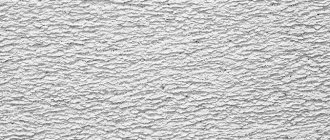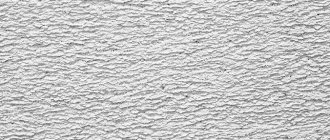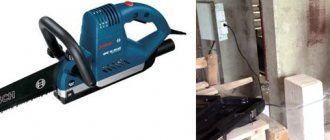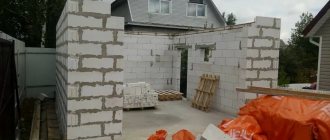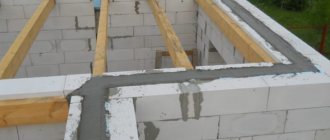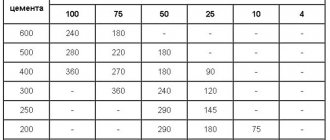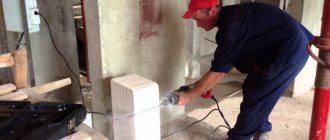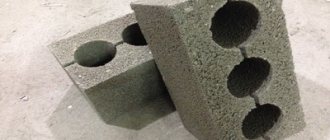Objects made from such material are quite common today. The blocks are lightweight and reliable, and have certain advantages when compared with simple concrete or brick material. First of all, builders highlight good thermal insulation properties, which are achieved by adding aluminum powder and plasticizers to the raw materials. But there is the opposite side of the coin - not very high strength. Therefore, you should choose the optimal sizes of aerated concrete blocks. In addition, during construction no additional measure is required, such as reinforcing walls from gas silicate blocks.
Aerated concrete block - what is it?
This is a stone of artificial origin, which is made from cellular concrete material. It should not be confused with foam blocks.
In the first option, voids arise due to chemical processes occurring inside, and in the second, from the addition of pre-prepared foam.
Quite often, aerated concrete and gas silicate are considered the same material. But in fact, the second type is considered a subspecies of the first. The main components used in manufacturing are the same in each case. The differences lie in their proportions and technological features of production. From this, materials differ in characteristics in terms of density, strength and ability to conduct heat.
In the production of aerated concrete they use:
- cement and sand;
- lime;
- clean water;
- aluminum powder as a gas-forming agent.
When water, aluminum and lime combine, hydrogen is released, which results in the formation of a large number of pores in the concrete mass, which in certain brands account for about eighty percent of the total volume. The more voids, the less strength the block has, but it weighs less. It should be added here that the thermal conductivity of the blocks leaves much to be desired.
Concrete is poured into molds and hardened, or is first sent to an autoclave. There, under the influence of high temperature and pressure, the material gains the required strength. This manufacturing technology is used to produce blocks used for the construction of residential buildings.
Aerated concrete dimensions
When developing a design solution for building a house and calculating the main parameters for strength and thermal insulation, as well as choosing masonry, it is imperative to determine the size of the aerated block for building a house.
When changing the shapes and parameters of blocks, the characteristics may change. GOSTs have been approved, according to which manufacturers are required to produce this material.
The blocks are U-shaped and rectangular. The first option is used for constructing window and door openings; it is used to fasten floor elements.
The dimensions of aerated concrete U-blocks are as follows:
- height – 25 cm;
- length – 50 or 60 cm;
- width – from 20 to 40 cm.
Rectangular shapes of the material are considered standard; the dimensions of aerated concrete blocks in this case will be as follows:
- height – 20 or 25 cm;
- length – 60 or 62.5 cm;
- in width - from 10 to 40 cm.
During construction work on the construction of internal walls, in most cases, aerated block material is used, the width of which is ten to fifteen centimeters, but the dimensions of aerated concrete blocks for load-bearing walls can be 20, 24, 30 and even 40 cm in width.
Given the level of load on the walls, these parameters may change. And when an increased load on the partitions is expected, the size of an aerated concrete block for the walls of a house can be as follows:
| length, width, height of aerated block, mm | volume of one element, cubic meters m | size of pallet with gas blocks, cm | quantity of material, pcs |
| 600 x 300 x 200 | 0.036 | 120 x 100 x 150 | 50 |
| 600 x 250 x 100 | 0.015 | 120 x 100 x 150 | 120 |
| 600 x 300 x 250 | 0.045 | 120 x 100 x 150 | 40 |
| 600 x 400 x 200 | 0.048 | 120 x 100 x 120 | 30 |
These are the most popular sizes of aerated concrete blocks for external walls used in construction. But the material with dimensions 625 x 250 x 200 and 625 x 250 x 100 is septal and is used to remove internal walls.
Is it possible to build in winter?
A house should be built from aerated concrete at an air temperature within (+5) – (+30) degrees. Construction should not begin in winter .
However, it is recommended to carry out all work in 1 season, and therefore they can be completed at low sub-zero temperatures, but with the availability of special winter adhesive compositions.
In this case, special attention should be paid to storing the blocks, avoiding moisture. The masonry area requires protection from precipitation.
What influences the parameters of the material
The dimensions of the blocks are determined by their thermal insulation and strength characteristics, taking into account the convenience and proportionality of masonry work, and the likely possibilities of facilitating the production process.
The main criterion is the width of the gas block. It is directly related to strength and ability to conduct heat. As a rule, this value is thirty centimeters, but depending on the expected loads it may be more or less. The length of the aerated block and its height are chosen taking into account the multiplicity of generally accepted dimensions of the object and the convenience of masonry work.
The choice of gas block parameters is made taking into account the expected loads on the walls, thermal conductivity requirements, and rational calculations in order to eliminate the use of expensive material if this is not necessary.
A number of conditions related to:
- storage;
- transportation;
- ease of use;
- price;
- construction deadlines.
Laying large blocks slows down the construction process because the mass of the aerated block is large, which slows down its movement around the site.
To know how much a gas block pallet weighs, you can use the table:
| parameters, cm | weight of 1 piece of aerated block, kg | weight of 1 m3 of aerated block, kg |
| 60 x 20 x 25 | 15.6 – 23.4 | 940 – 1 400 |
| 60 x 20 x 30 | 18.7 – 28 | 940 – 1 400 |
| 60 x 20 x 40 | 24.4 – 37.4 | 740 – 1 130 |
| 60 x 25 x 10 | 7.62 – 11.7 | 940 – 1 400 |
| 60 x 25 x 15 | 11.7 – 17.6 | 940 – 1 400 |
| 60 x 25 x 25 | 19.5 – 29.3 | 940 – 1 400 |
| 60 x 25 x 30 | 23.4 – 35.1 | 940 – 1 400 |
| 60 x 25 x 37.5 | 29.2 – 43.9 | 940 – 1 400 |
| 60 x 25 x 40 | 30.48 – 46.8 | 740 – 1 130 |
Knowing how much a gas block weighs and what sizes it comes in, you can easily determine how many pieces will be on the pallet. In this case, it is necessary to take into account one more indicator - the density of the material.
Advantages and disadvantages of aerated concrete material
The advantages of blocks include:
- excellent sound insulation of the facility. Walls thirty centimeters thick give a reading of 60 dB;
- the low density of the blocks gives them light weight. The material is five times lighter than concrete, and two to three times lighter than brick;
- the gas block is easy to process - it can even be cut with a regular hacksaw;
- low thermal conductivity. If we take walls made of aerated concrete and brick of equal thickness, then the first option will exceed its analogue by almost five times;
- environmental friendliness and safety - no hazardous components are used in the production process;
- good speed of construction work. One block can replace a masonry of ten to fifteen bricks;
- aerated concrete masonry does not create “cold bridges”;
- cellular concrete perfectly resists exposure to open flames.
In terms of cost, aerated concrete is much cheaper than other materials. In addition, the blocks have good vapor permeability. This makes it possible to compare them with wood. You just need to choose the right brand of material.
If partitions are being erected or thermal insulation layers are being installed, it is recommended to use blocks with small dimensions in thickness and with the maximum number of internal pores. But for load-bearing structures you should take blocks with maximum density and strength.
If we talk about disadvantages, there will be only two main ones:
- high moisture absorption;
- low strength index.
The low level of strength of the material will not affect the house if all technological features of construction work are followed.
The pores in the block perfectly retain heat and isolate extraneous noise. But at the same time, void areas reduce the strength of the material. For this reason, aerated concrete is recommended to be used for load-bearing walls if a building of one or two floors is being built. Otherwise, the lower rows of masonry may become deformed.
Aerated concrete is able to “breathe” and allow water vapor to pass through. But at the same time, the pores are an excellent reservoir in which moisture accumulates. If the waterproofing is poor, the block gets wet, which significantly increases its thermal conductivity. Ultimately, the energy efficiency of this building material disappears instantly.
At its cost, aerated concrete is significantly lower than brick material, wood and other competitors. But remember that you will have to incur additional costs for the waterproofing layer and finishing of the facade.
A cellular block that does not have protection from the street will not last long. Water that gets into the walls will contribute to heat loss and destroy blocks during frosts.
Cost of aerated blocks
It is extremely rare for sellers of aerated blocks to offer them at a price per piece. Most often, the cost is indicated per 1 cubic meter, this is how products are released from the factory. So, it doesn't matter what block size you take. The manufacturer varies the price mainly depending on the density - or strength class options, if they provide them.
For example, DSK GRAS Saratov in May 2022 offers D400 blocks of class B2.5 at 3,650 rubles/m³. D 500 with the same strength costs 3,700 rubles/m³. You can choose from blocks of the same density, but class B3.5 - the price remains the same.
As for the difference in prices between blocks from one manufacturer or another, they are due to the popularity of the brand, better quality and geometry, and a higher strength class. For example, blocks of the famous Bonolit brand cost 4,300 rubles/m³ in all density options. The exception is the D300 units, which, on the contrary, are more expensive - 4,400 rubles. The reason for this is obviously the additional difficulties that arise in the production of low-density products with unusual high strength B2.
The more famous the brand, the higher the price tag for its products - this is true for any product, and aerated concrete is no exception. For example, for blocks under the YTONG logo (the whole history of aerated concrete began with it) you will have to pay at least 5,000 rubles/m³. Meanwhile, on the Russian construction market there are blocks of no worse quality and an order of magnitude cheaper - you just need to find them.
Types of material
Technological features of block manufacturing are divided into several ways:
- autoclave - this method is also called the synthesis hardening process. Solidification occurs in an autoclave under high temperature and pressure;
- non-autoclave - hydration cooling. The process takes place in an environment with saturated vapors, and heating with electrical devices is used.
Based on the main binder component, blocks are divided into:
- cement - the composition consists of fifty percent of this material;
- limestone – contain an increased amount of quicklime;
- slag - more than half of the raw materials consist of slag and gypsum;
- ash - they contain a large percentage of highly basic ash.
A separate group is a mixed block, which includes lime, cement mass and slag.
How to dry the building after completion?
Dampness in a house made of aerated concrete has a detrimental effect on both the structure itself and the health of the residents. There are several ways to dry a built house:
- Forced ventilation. It is best to include it in advance in the house design.
- Mobile installations. When there is high humidity, it becomes necessary to use special air heaters.
- Windows with micro-ventilation function. For this purpose, special frames are installed through which air exchange occurs in the room. It is important to ensure that the incoming cold air is warmed up.
In any case, the moisture content of aerated concrete should not exceed 25%. At higher values, forced drying is necessary.
If the humidity is within reasonable limits, then effective heating and periodic ventilation are ensured. How long does it take for a house made of aerated concrete to dry after construction? Its walls dry out within 2-3 heating seasons.
Tips from the professionals
If you decide to build a building from such material, you should use some recommendations:
- The blocks are installed using special glue. When creating a seam, you must use a trowel;
- To make a groove, it is best to use a grinder and a diamond-coated disk;
- in order to speed up the process of construction work, it is allowed to use special blocks having suitable shapes when creating window and door openings;
- When laying blocks, you must use a building level. This will allow you to control the evenness of the surface and avoid subsequent deformation manifestations. When adjusting elements, a grinding machine helps a lot;
- It is not recommended to lay masonry from two corners at the same time;
- It is best to cut aerated concrete blocks with a special saw;
- Before construction begins, a waterproofing layer is applied to the foundation.
Having studied the technical characteristics, properties and dimensions of the blocks, you will be able to choose the right material from which to build an inexpensive, but quite comfortable room.

